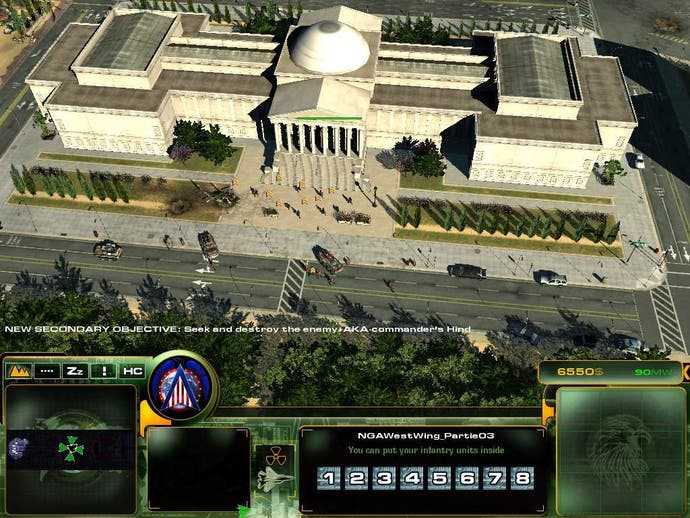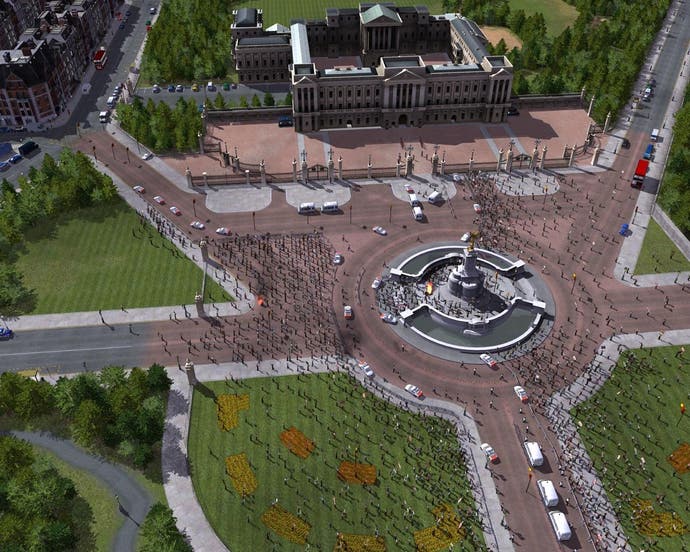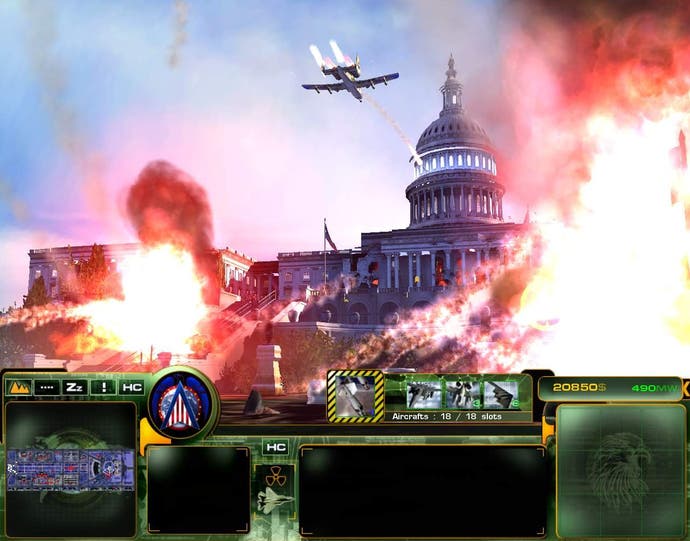Act of War: Direct Action
Not the "Lights! Camera! Action!" kind of Direct Action.

It's a Real-Time Strategy Game.
This, if nothing else, makes Act of War: Extraneous Subtitle something of a rarity in the busy gaming world of 2005. While every other game seems to be integrating elements of everything from role-playing games to platform games (at least in the case of the widely anticipated Command & Conquer: Its-a Me! Yuri!), Act of War keeps things familiar. If you brought someone forward in time from those crazy salad days of the mid-nineties, and put a line-up of games before them, they'd identify Act of War with a cheery "Yes - that's the RTS". It has Strategy. It's in Real Time! It's a game! It has Strategy and it's in Real Time and it's a game! It's a Real Time Strategy Game!
[Actually, it's a Flight Sim -Inevitable Pedant]
That's not necessarily a bad thing. If the entire world is changing around you, a way to secure your identity is to just stay in the departed niche. So while everyone else gets a little closer to the action and try to ape Warcraft III, this leaves Act of War doing the near-future war thing virtually all by its lonesome. Well... at least until another C&C trundles along anyway.
The game's structured around the familiar campaign, skirmish and online play, but each comes with their own, highly distinctive twists. Well... okay, only the campaign comes with its own highly distinctive twists, but it sounds like I'm demeaning the game if I say "The campaign comes with its own highly distinctive twists and everything's the same as usual". And, since the LAN and Skirmish play are an effective and brutal take on the form, that'd be a terrible thing to do.

Arranged into thirty-three chapters, the campaign unfolds with a more cinematic bent than most recent games. As well as rendered sequences and in-engine cut-scenes, we have window-in-window effects which open a monitor to show what's happening elsewhere and even real-life footage while you're on a mission. The last is, absolutely shockingly, a revelation. The traditional arguments against live footage in games is that it breaks atmosphere by cutting between these perfect images of people and the pixelated people in game.
In the years since footage became officially Unclean in the gaming public's eyes, the graphical power of engines has advanced to reduce the dissonance between the pair to far more reasonable levels. The second traditional problem - that the video features wooden sets and acting of a similar quality - is avoided by actually doing it in a decent fashion. While this is far from Oscar-winning stuff, it works in a straight-to-video action fashion. Yes, some are distinctly ropey - though no more than most in-game cut-scenes - but others left me hungry and, ahem, pumped for action. With the missions deliberately short, and the larger ones cut into sections, this leads to a game which moves at the pace of a CNN news program.
Added bonus: In cut-scenes featuring real people, you don't get that disgusted feeling with yourself when you find yourself fancying a character.
In the campaign itself, you get to control two of the three sides of the game: the US Army and Task Force Talon. To play the third, The Consortium, you'll have to step into a skirmish or online arena. They're well defined groups that manage to stick to the vaguely credible mandate of the game, while still being different from each other in most areas. The US army is closest to the traditional side, even if it is a little over-specialised, featuring well-balanced forces whose strength is in their powerful hardware. Task Force Talon are equipped with near-future equipment like drones and exoskeletons, and mix increased flexibility with speed. The Consortium are a distinct switch, relying on wave attacks of cheap soldiers and tanks at the start of a game before progressing to ultra-high tech nearer the close.

Resources, while nothing too far from the genre template, have some interesting aspects. On most maps, you'll either have to take oil wells or banks. The latter will pay out at a set rate as long as they're held by your soldiers. The former require the services of a Derrick and a refinery to tap the Black Gold. Both run dry eventually, forcing you to secure other resources or make sure you have enough of the game's renewable one. That is, Prisoners of War. If not killed, soldiers and operators can be captured by foot soldiers, where they're stored and pay off at a set rate. This means that, in the Skirmish games at least, you'll find yourself trying to stop your soldiers being taken away to a camp.
The campaign's structure is helped immeasurably by the powerful Engine that the team at Eugen have set to task simulating their world. Entire cityscapes are rendered with nary a flicker of a computerised eyebrow. The opening levels, in London, feature genuine crowd-scenes, which must be some small step towards the glorious day when someone puts a club in a videogame and it's actually got more than two people and a dog on a string in it. Best of all are the explosions, which mark Eugen as the spiritual heirs of the dear departed pyromaniacs at Rage Software.
In short: things go bang.
It also has moments of inspiration with its units. It offers a particularly vicious take on the rock/paper/scissor design, with ill-chosen units being absolutely annihilated against the wrong opposition. If an enemy is defenceless against something which you've an excess of, things can be brutal - like seeing a mob of helicopter gun-ships chew up a tank advance. However, equally, see how long that same squadron lasts when it charges into range of anti-aircraft defences. Thinking about what works, and making sure you have it available is a prime asset. Especially helpful here are the more adaptable units, such as the S.H.I.E.L.D. exoskeleton soldiers, who can be ordered to swap between rocket launchers and mini-guns depending on whether they're fighting vehicles or troops. The troops themselves are another strong point. Some are able to crawl for reconnaissance-style actions and all are able to enter buildings to defend and hold them. Ambushing can be set, which doubles the firepower of the unit and proves a particularly nasty tactic in an urban area with buildings full of rocket-firing men waiting for passing tanks. Air strikes are well judged, providing a sizeable, if vulnerable, strategic resource.

In terms of failings, it stumbles in some of the fine details of the interface. Perhaps tellingly, this normally shows up areas of the game where Eugen has chosen to push the genre in more unfamiliar areas and is forced to innovate rather than carefully use the tried-and-trued approaches. The most noticeable such failing applies to the infantry. While the game stresses the humble foot soldier more than most, their extended skill palette can make things difficult. For example, you jump off a vehicle (or out of a building) by pressing a disembark button. However, if you have selected more than just the transporters, that option disappears, meaning you have to choose the vehicles individually. When you're moving a mass formation, this makes swift disembarkation awkward. A similar niggle hits when playing with buildings. You can work your way around this through judicious use of grouping shortcuts to skip between the various components of your forces, but this still hardly allows you to fluidly alter tactics on the fly. If you haven't got time to reorganise, then things can become a muddle.
Perhaps more deeply, while the multiplayer mode seems to hold the potential for thrust and counterthrust, the single-player campaign - while a glorious techno-thriller rush - can seem tactically unsophisticated. While you can show a little animal cunning, you often find that the group-select-all-and-click will do the trick as well, as long as you're paying attention. Manually selecting targets for certain killer groups - a mob of the Task Force Talon's heavy snipers, for example - and then clicking through the nastiest of the targets can whittle down an opposing formation with embarrassing haste. On a similar Pretty But Dumb comment, the Skirmish AI, especially at lower levels, is agreeably aggressive but still tends to send waves of soldiers in against an overpowering defence.
But, while pointing in these complaints' direction, it's worth noting that... well, if they were terminal faults, the whole genre would have curled up in a corner and died years ago. It hasn't, it lives still and while Act of War doesn't transcend its genre, in terms of doing the pure Red Alert thing, there hasn't been anything as competent and thrilling in ages. I'm not sure if it'll dethrone Command & Conquer from its position - a franchise is a dangerous thing to fight on its home turf, and actual quality often a secondary issue - but if it did, it's be churlish to complain.
Yes, it's a Real-Time Strategy game. But, more importantly, it's a good one.
For more on Act of War, visit the Eurogamer Act of War Mini-site.

